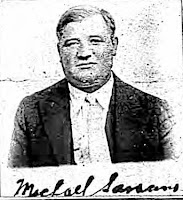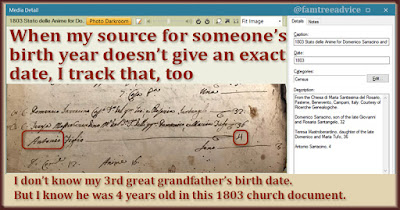Take a look behind the spreadsheet and see how it can help your research.
I've written many times about my document tracker. It's an Excel spreadsheet I created 12 years ago to help me build my family tree.
The spreadsheet shows each genealogy document I have for any given person in my family tree. Take my great grandfather, Giovanni Sarracino, for example.
- To see which of his census records I had, I'd open the census folder on my computer.
- To see if I had his draft registrations cards, I'd open the draft cards folder.
- For immigration records, I'd open my immigration folder.
I could also look at the media files attached to him in Family Tree Maker. I display the images chronologically, so I'd have to browse them all to find a particular type of document.
Wouldn't it be easier to have an inventory of all his documents in one row of a spreadsheet? (Spoiler alert: It's much easier.)
The spreadsheet has a column for a person's name and a column for each major document type:
- birth
- baptism
- immigration or travel
- marriage
- naturalization
- census
- draft registration
- death
- burial
- passport application
- city directory
You may not want to track all those documents. I actually have very few baptism or burial records. I arranged the document types in chronological order, mostly. Your document tracker can have the headings you prefer, in whatever order you like.
| In 12 years, I haven't regretted this document tracker for a minute. |
An important feature for me is the last column: Need to find. This is a list of missing documents for each person. Let's look at my 1st cousin twice removed, Michele Sarracino as an example.
I don't know a lot about Michele, but I have his 1899 birth record from Italy. I also found him in the Bronx, New York, census in 1905, 1915, 1920, and 1925. Then he disappeared.
So I added his missing documents and major facts to his Need to find column:
- 1904 immigration (according to his 1920 census)
- 1910 census
- 1930 census
- 1940 census
- WW1 draft registration card
- WW2 draft registration card
- marriage?
- death
I can track his family members, but I don't even know if Michele married.
The Need to find column is the quickest way to see what's missing for any given relative. Let's see if some research can move some items to their proper columns.
In a search on Ancestry I saw a World War I draft registration card. It had a different spelling for his last name (Saracena), but it had his exact birth date: 29 Nov 1899.
The card shows his 1918 address on East 150th Street in the Bronx. That's right where my family lived. It lists his mother as Josephine, which matches my facts. And his signature looks like Saracino, which is how my family began to spell it several years later.
 |
| Thanks to his Italian birth record and the exact birth date, I knew this was my cousin. |
As a bit of icing on the cake, Michele's draft registration describes his blue eyes and blond hair. I was teased as a child for being too light to really be an Italian-American. My Southern Italian 1st cousin twice removed proves what nonsense that was.
Now I can add this document to my family tree. I'll also remove WW1 draft registration card from his Need to find list and put WW2 (doc.) in his Draft column.
 |
| My 1st cousin twice removed: Babe Ruth's double! |
That gives me some new clues. Michele lived at the same address in 1925 and 1945. He should be there with family members in 1930 and 1940. I found his siblings, but Michele wasn't there.
Next I found his Social Security Death Index from 1965.
I learned that in 1935 and 1941 Michele was not married. And he had moved up in the world: a junkman in 1918, a laundry helper in 1920, a chauffeur in 1925, and in 1935, proprietor at an automobile sales agency.
I like to use my document tracker to guide my research on days when I don't have a specific goal in mind.
Some tips: To distinguish between document images and undocumented facts, I use different wording:
- (cert.) after the year means I have an image of the birth, marriage, or death certificate
- (doc.) after the year means I have an image of the ship manifest
- WW1 (doc.) or WW2 (doc.) in the Draft column means I have an image of the draft registration card
- (index) after a birth, death, or marriage year means I saw the fact listed in a government index. But I did not see the document.
- A year, all by itself, means I have evidence of the year, but no document to back it up. For example, my 3rd great grandfather Antonio Sarracino was born in 1799. I know this because he was 4 years old on a record written in 1803 documenting the members of his household. But I don't have his birth record.
- Abt. before a year means it's an estimate.
- When a document is currently unavailable, but may be available in the future, in the Need to find column I add:
- out of range: birth
- out of range: marriage
- out of range: death
I don't add (doc.) after a census year because if I have the document, the year is there. If I don't, it's in the Need to find column. Do whatever is logical to you.
 |
| It's helpful to include a birth year in the document tracker, even if there is no document. |
Today my family tree has 22,846 people, but my document tracker has 2,827. That means I have 20,000 people in my tree with no documents at all. That's because I have incredibly distant relatives in my tree. I don't always take the time to process and add all their vital records as I find them.
Create your own document tracker or download the sample I made for you. It has the columns filled in and one person as an example. Let me know if you have any questions.
And speaking of the document tracker:
I do love this idea, but find it a little daunting. Trying to figure out if I can import the names from my family tree into Excel (well, I know it can be done - just have to do it) and then start from there... Thanks for the sample :) I recently found a copy of my great-grandfather's burial record...I don't have many of those and this one completed pretty much everything I need for him.
ReplyDeleteI did it using Family Tree Analyzer, where I can create an All Individuals Report, export to .csv and then import to Excel. There were a few more fiddles, but I finally got everyone into the document tracker :)
ReplyDeleteNice work!
DeleteWhat kind of notes do you link to in the final column?
ReplyDeleteNo links, just a list of missing items. You can see an example of the last column up above in the first image on this page.
DeleteAs you said, you have 2,827 out of 22,846 people that are listed on the tracker. Who would you start with? And to throw a wrench into that question, my genealogy is a descendancy so, I would guess, start with my direct line and then move out to my mother's sibling's, my grandfather's siblings, etc?
ReplyDeleteWhen I started this chart, I began by looking at one folder of document images at a time. For example, start with the census folder and add everyone on each census image to the document tracker.
DeleteAnother wrench - using the Register System, each person has his/her own folder with copies of documents and pictures inside. A few folders have been divided by subject (certificates, pictures, stories, etc.). I have started on Travel and have found lots of trips buy my self and parents; this is fun!
ReplyDeleteDiAnn - I was referring to Column N, beside To Find, which is headed "Link to Notes"... :)
ReplyDeleteI had forgotten I did that in my downloadable file. You don't have to do it that way, but it's linking to notes on another tab of the spreadsheet. It's a way to record your research notes.
Deleteah I see :) Will investigate that... Thanks!
Delete